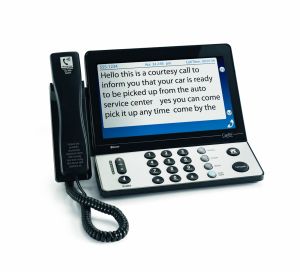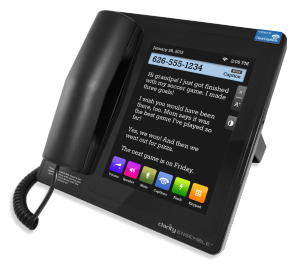For people who are living with severe to profound hearing loss, captioned phones can be an excellent tool to help you communicate with friends, family members and professional contacts. Captioned phones are especially important because phone conversations are often difficult for people with hearing loss as they are not able to rely on lip reading and contextual cues to derive meaning from conversations.
Telephones typically do not transmit the full frequency range of speech, which can present a real challenge for anyone whose speech understanding is already compromised. Many people with untreated hearing loss shy away from using the phone or rely on others, often isolating themselves, which can contribute to loneliness, depression and other negative health effects.
Table of Contents
History of captioned phones

text that is easy to read.
In the 1960s, scientist Robert Weitbrecht’s own profound hearing loss inspired him to develop a teletypewriter—also known as TTY. The TTY device became common in public places and homes, especially after the late 1970s and 1980s when more compact versions were created. TTYs allowed deaf people to make phone calls with others who had the devices. Eventually, relay services were developed so people with hearing loss using TTYs could communicate easily with people who had regular telephones.
When Title IV of the Americans with Disabilities Act (ADA) was passed in 1990, the government mandated that relay services be available nationwide giving people with hearing loss the same access to telephone use as others.
The invention of TTY and the enactment of the ADA directly contributed to the development of captioned phones, and the first one—CapTel—was introduced in 2003.
How captioned phones work
Captioned telephones can be used in a home or at work and have a built-in screen that displays text captions of the conversation during the call in near-real time. When a call is made, the captioned phone automatically connects to a Captioned Telephone Service (CTS). When the other person answers the phone, the caller hears whatever they say just like with a traditional telephone call. At the same time, the CTS uses advanced voice recognition technology and specially trained communications assistants to transcribe everything that is said into captions, which appear in almost simultaneously on the phone display.
The CTS system is part of the Telecommunications Relay Service (TRS). Under ADA guidelines for hearing loss, this service is offered free of charge to people who are deaf or hard of hearing. In-state phone calls are traditionally supported by TRS at the state level, while interstate calls are paid for by the FCC’s TRS program.
The Americans with Disabilities Act (ADA) in 1990 ensured people with hearing loss had the same access to telephone use as others.
The FCC recently ruled that Internet Protocol Relay services can be funded as well. The only difference in IP CTS services is that they are routed through the internet to the captioned telephone, rather than via phone lines.
Caption apps for smartphones and tablets
Additionally, there are currently some smartphone apps available to provide captions when making a call. Other options can display telephone captions on a computer screen. Some of these options have fees or require a purchase.
Here’s some of the best apps for phone captioning.
Privacy
Captioned telephone users don’t need to worry about privacy concerns. Captioned phone service providers are Federal Communications Commission (FCC)-regulated and have strict obligations for confidentiality for all users. FCC regulations governing relay services mandate that no records of any call content are recorded or stored. Captioned phones that use an internet connection use encrypted, FCC-regulated transcription which is considered very secure.
Getting a captioned phone
Anyone with a hearing loss that impairs telephone use may be an eligible candidate for a captioned phone. FCC regulations prohibit the use of captioned telephone services by people who don’t have a hearing loss that necessitates it. See a hearing care professional or a captioned telephone retailer for more information.
There are a variety of captioned telephones available from different providers, including CapTel, Clarity Ensemble by ClearCaptions and CaptionCall. One can purchase phones directly from websites or local retailers. Also, many people qualify for special state programs where they can obtain a captioned phone at a reduced rate or for free. Check with a local hearing care provider or area disabilities service to see if these programs are available nearby. Some captioned telephone providers offer free delivery as well as installation, set-up and user training at no charge.
In some programs, FCC regulations require a Professional Certification form signed by a hearing care practitioner or other health services professional to receive a free captioned telephone and captioned telephone service. The form certifies that an individual has a hearing loss and requires Captioned Telephone Service to communicate effectively by telephone.
Types
CaptionCall
CaptionCall has a sleek design, state-of-the-art captioning and has a telecoil loop connection for people who wear hearing aids. CaptionCall allows users to save conversations and save previous volume settings to maximize their time and create efficiency.
CapTel
CapTel is a user-friendly captioned telephone that summons captions at the push of a button. Two options are available—one for people with WiFi and another that works with a standard analog phone. Some models are made for people with low vision, too.

ClearCaptions
ClearCaptions
The Ensemble™ with ClearCaptions is an amplified home phone that displays captions in near real-time on a large 8-inch color touchscreen. It also features one-touch text sizing, speakerphone for hands-free calling and a built-in answering machine. They also offer an app for smartphones.
What to expect
Captioned telephones are readily available, relatively inexpensive, easy to use and can be used with hearing aids or without. These assistive listening devices are not perfect—there can be a slight lag in captions and the captioning may occasionally have minor inaccuracies. However, many users report feeling confident on the phone again after years of avoiding calls or just pretending they understood, and they finally feel connected to distant relatives and friends again. Many offices provide captioned phones for their deaf or hard of hearing employees.
If you have hearing loss, seek help right away from a local hearing care professional. They can help you choose all of the best solutions including information to get a captioned phone, hearing aids and other accessories to get you connected to life again.

